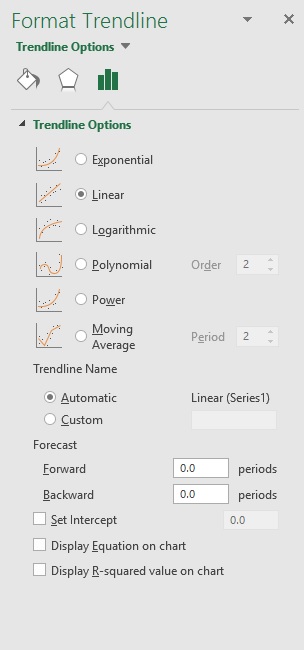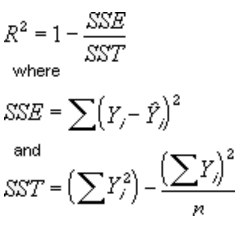How To Add A Trend Line In R
Notation:These steps utilize to Office 2013 and newer versions. Looking for Office 2010 steps?
Add a trendline

-
Select a chart.
-
Select the + to the meridian right of the chart.
-
Select Trendline.
Note:Excel displays the Trendline option only if yous select a chart that has more than than one data serial without selecting a data series.
-
In the Add Trendline dialog box, select any data series options you want, and click OK.
Format a trendline
-
Click anywhere in the chart.
-
On the Format tab, in the Current Choice grouping, select the trendline option in the dropdown list.
-
Click Format Option.
-
In the Format Trendline pane, select a Trendline Option to choose the trendline you lot want for your chart. Formatting a trendline is a statistical style to measure data:

-
Set a value in the Forrard and Backward fields to project your data into the hereafter.
Add a moving average line
You can format your trendline to a moving average line.
-
Click anywhere in the chart.
-
On the Format tab, in the Current Selection group, select the trendline option in the dropdown listing.
-
Click Format Option.
-
In the Format Trendline pane, nether Trendline Options, select Moving Boilerplate. Specify the points if necessary.
Note:The number of points in a moving average trendline equals the total number of points in the series less the number that you specify for the menstruation.
Add a trend or moving average line to a chart in Function 2010
-
On an unstacked, 2-D, area, bar, column, line, stock, xy (scatter), or bubble chart, click the data serial to which you want to add a trendline or moving average, or do the following to select the data serial from a listing of chart elements:
-
Click anywhere in the chart.
This displays the Nautical chart Tools, adding the Blueprint, Layout, and Format tabs.
-
On the Format tab, in the Current Pick grouping, click the arrow next to the Nautical chart Elements box, so click the chart element that you want.

-
-
Annotation:If you select a chart that has more than ane information series without selecting a data series, Excel displays the Add Trendline dialog box. In the list box, click the data serial that you want, and then click OK.
-
On the Layout tab, in the Analysis group, click Trendline.

-
Do one of the following:
-
Click a predefined trendline option that you want to utilise.
Note:This applies a trendline without enabling you to select specific options.
-
Click More Trendline Options, so in the Trendline Options category, under Tendency/Regression Blazon, click the blazon of trendline that yous desire to use.
Use this type
To create
Linear
A linear trendline by using the post-obit equation to calculate the least squares fit for a line:

where m is the slope and b is the intercept.
Logarithmic
A logarithmic trendline by using the post-obit equation to calculate the least squares fit through points:

where c and b are constants, and ln is the natural logarithm role.
Polynomial
A polynomial or curvilinear trendline past using the post-obit equation to calculate the least squares fit through points:

where b and
 are constants.
are constants.Ability
A power trendline by using the post-obit equation to summate the least squares fit through points:

where c and b are constants.
Note:This pick is not available when your data includes negative or zero values.
Exponential
An exponential trendline by using the following equation to calculate the least squares fit through points:

where c and b are constants, and e is the base of the natural logarithm.
Note:This option is not bachelor when your data includes negative or zippo values.
Moving average
A moving average trendline by using the following equation:

Annotation:The number of points in a moving average trendline equals the total number of points in the series less the number that you specify for the period.
R-squared value
A trendline that displays an R-squared value on a chart by using the following equation:

This trendline option is available on the Options tab of the Add Trendline or Format Trendline dialog box.
Note:The R-squared value that you tin display with a trendline is not an adjusted R-squared value. For logarithmic, ability, and exponential trendlines, Excel uses a transformed regression model.
-
If you select Polynomial, type the highest power for the independent variable in the Order box.
-
If you select Moving Average, type the number of periods that you want to apply to summate the moving average in the Period box.
-
If you add together a moving average to an xy (scatter) chart, the moving average is based on the gild of the x values plotted in the chart. To get the upshot that you want, you might have to sort the 10 values before you add together a moving average.
-
If yous add a trendline to a line, column, area, or bar chart, the trendline is calculated based on the supposition that the ten values are 1, 2, three, four, 5, 6, etc.. This assumption is made whether the x-values are numeric or text. To base of operations a trendline on numeric x values, y'all should utilize an xy (scatter) chart.
-
Excel automatically assigns a name to the trendline, merely you tin change it. In the Format Trendline dialog box, in the Trendline Options category, under Trendline Name, click Custom, and and so blazon a proper name in the Custom box.
-
Tips:
-
You can too create a moving average, which smoothes out fluctuations in data and shows the pattern or trend more clearly.
-
If yous alter a chart or information series so that it tin no longer support the associated trendline — for example, by irresolute the nautical chart type to a 3-D nautical chart or past changing the view of a PivotChart report or associated PivotTable written report — the trendline no longer appears on the chart.
-
For line data without a nautical chart, you can utilize AutoFill or one of the statistical functions, such as GROWTH() or Tendency(), to create data for all-time-fit linear or exponential lines.
-
On an unstacked, two-D, area, bar, column, line, stock, xy (scatter), or bubble nautical chart, click the trendline that you lot want to alter, or do the following to select information technology from a list of nautical chart elements.
-
Click anywhere in the chart.
This displays the Chart Tools, adding the Blueprint, Layout, and Format tabs.
-
On the Format tab, in the Current Selection grouping, click the arrow next to the Chart Elements box, and so click the chart element that you want.

-
-
On the Layout tab, in the Analysis group, click Trendline, and then click More than Trendline Options.

-
To change the color, style, or shadow options of the trendline, click the Line Color, Line Style, or Shadow category, and then select the options that you want.
-
On an unstacked, two-D, area, bar, column, line, stock, xy (scatter), or chimera chart, click the trendline that yous want to change, or do the following to select information technology from a list of nautical chart elements.
-
Click anywhere in the chart.
This displays the Chart Tools, calculation the Blueprint, Layout, and Format tabs.
-
On the Format tab, in the Current Option group, click the pointer adjacent to the Nautical chart Elements box, and and so click the nautical chart element that you desire.

-
-
On the Layout tab, in the Analysis group, click Trendline, and then click More Trendline Options.

-
To specify the number of periods that yous want to include in a forecast, under Forecast, click a number in the Forward periods or Backward periods box.
-
On an unstacked, 2-D, area, bar, column, line, stock, xy (scatter), or bubble chart, click the trendline that you want to change, or do the following to select it from a list of chart elements.
-
Click anywhere in the chart.
This displays the Chart Tools, adding the Design, Layout, and Format tabs.
-
On the Format tab, in the Current Selection group, click the pointer side by side to the Chart Elements box, and then click the nautical chart element that you lot desire.

-
-
On the Layout tab, in the Assay grouping, click Trendline, and so click More Trendline Options.

-
Select the Set Intercept = check box, and then in the Set Intercept = box, type the value to specify the signal on the vertical (value) axis where the trendline crosses the centrality.
Note:Y'all can do this merely when you utilise an exponential, linear, or polynomial trendline.
-
On an unstacked, two-D, area, bar, column, line, stock, xy (scatter), or bubble chart, click the trendline that you want to change, or do the post-obit to select information technology from a listing of chart elements.
-
Click anywhere in the chart.
This displays the Chart Tools, adding the Design, Layout, and Format tabs.
-
On the Format tab, in the Current Pick grouping, click the arrow next to the Chart Elements box, and then click the nautical chart chemical element that yous want.

-
-
On the Layout tab, in the Analysis grouping, click Trendline, and then click More than Trendline Options.

-
To display the trendline equation on the nautical chart, select the Display Equation on chart cheque box.
Note:Y'all cannot display trendline equations for a moving average.
Tip:The trendline equation is rounded to make it more than readable. However, you tin can change the number of digits for a selected trendline characterization in the Decimal places box on the Number tab of the Format Trendline Label dialog box. (Format tab, Electric current Selection grouping, Format Selection button).
-
On an unstacked, 2-D, area, bar, cavalcade, line, stock, xy (scatter), or bubble chart, click the trendline for which y'all want to display the R-squared value, or do the following to select the trendline from a listing of chart elements:
-
Click anywhere in the chart.
This displays the Nautical chart Tools, adding the Design, Layout, and Format tabs.
-
On the Format tab, in the Electric current Option group, click the pointer next to the Chart Elements box, and then click the chart element that y'all want.

-
-
On the Layout tab, in the Analysis group, click Trendline, and then click More Trendline Options.

-
On the Trendline Options tab, select Display R-squared value on nautical chart.
Annotation:You cannot display an R-squared value for a moving boilerplate.
-
On an unstacked, 2-D, area, bar, column, line, stock, xy (scatter), or bubble chart, click the trendline that you desire to remove, or exercise the following to select the trendline from a list of chart elements:
-
Click anywhere in the chart.
This displays the Chart Tools, adding the Design, Layout, and Format tabs.
-
On the Format tab, in the Current Choice grouping, click the arrow next to the Chart Elements box, and then click the chart element that yous desire.

-
-
Do one of the following:
-
On the Layout tab, in the Analysis group, click Trendline, and then click None.

-
Press DELETE.
-
Tip:You lot tin as well remove a trendline immediately after you add together it to the chart by clicking Undo  on the Quick Access Toolbar, or by pressing CTRL+Z.
on the Quick Access Toolbar, or by pressing CTRL+Z.
How To Add A Trend Line In R,
Source: https://support.microsoft.com/en-us/office/add-a-trend-or-moving-average-line-to-a-chart-fa59f86c-5852-4b68-a6d4-901a745842ad
Posted by: steinmetzocas1943.blogspot.com


0 Response to "How To Add A Trend Line In R"
Post a Comment